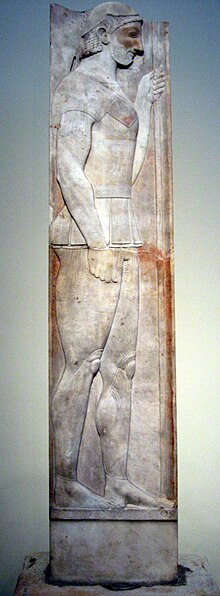Stele of Aristion
The Stele of Aristion or the Marathon Stele is a funerary stele in the National Archaeological Museum, Athens (NAMA, inventory number 29) which dates from around 510 BC. The work is among the best sculptures from late Archaic Greece.


The sculpture was discovered in Velanideza in Attica in 1839. It is made of Pentelic marble and measures 2.02 m high. The stele was found with its base, which is 0.24 m high. The uppermost portion of the head and helmet is missing. At the top of the base is an inscription, giving the name of the deceased in the genitive: [1] Ἀριστίονος "Aristion's". Aristion is depicted as a bearded hoplite soldier in profile, facing right. He wears a short, thin chiton under a corselet. This was originally decorated with painted designs: Meanders, zig-zags, and a star on his shoulder. The rest of the statue was also extensively decorated with paint - traces of red, yellow, and blue paint still survive. Aristion also wears an Attic helmet and greaves. His right arm hangs at his side, his left hand holds a spear. Some details are especially well-worked, like the wavy beard, the hair, and the musculature of the arms, legs and chest.
In the empty space under his feet there is a horizontal inscribed band, which names the sculptor of the stele: ἔργον Ἀριστοκλέος "Work of Aristokles."[2]
References
- ^ Inscriptiones Graecae (IG) I³ 1256; Image of the inscription.
- ^ Probably not to be identified with either of the sculptors of that name known from the ancient literary tradition
Bibliography
- Nikolaos Kaltsas: Sculpture in the National Archaeological Museum, Athens. The J. Paul Getty Museum, Los Angeles 2002, ISBN 0-89236-686-9, p. 70.
